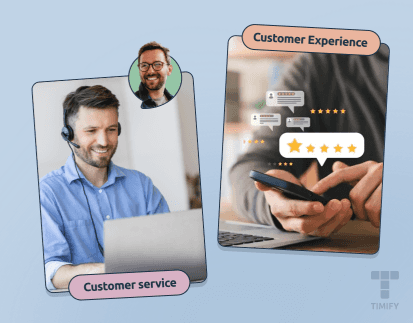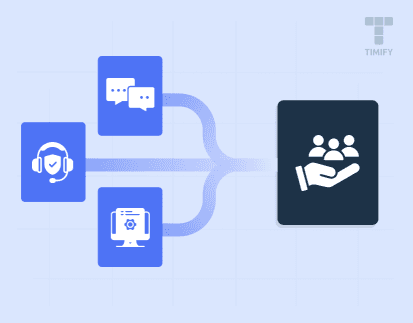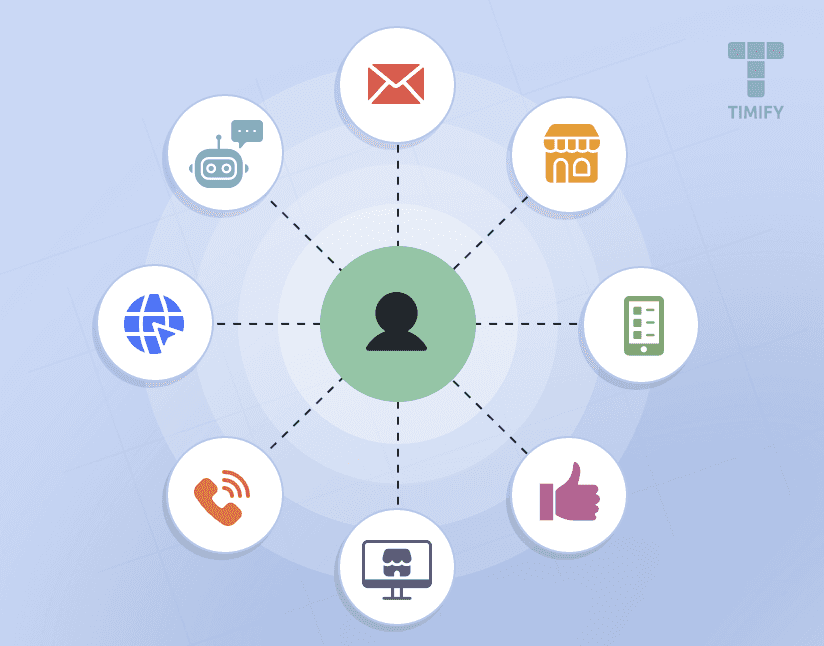

Juliia Serdiuk
Juliia Serdiuk is an Outreach Specialist at HelpCrunch, all-in-one customer service software.
Meet Ava Chen, dedicated founder of Craftopia — a thriving chain for arts, crafts, and DIY projects.
(OK, Craftopia may not be a real-world chain, but problems like Ava's are very much real!) ????
Fueled by Ava’s creative vision, things went smoothly at first. Lately, however, Ava and her team have noticed more customer complaints rolling in. Customers struggled with confusing, fragmented experiences between the website, retail stores, and workshops. One upset customer even posted a viral review about glitchy registration for a sold-out weaving class.
Ava realized these disjointed systems were contrary to the cohesive, inspiring service she aimed to provide. After doing some research, she decided that omnichannel customer support could help.
In this article, we follow Ava on her journey discovering exactly what omnichannel support is all about and highlight how businesses like Craftopia, or many others, can implement it.
Let’s start with the essentials.

Omnichannel support 101: What it is and how it stands out from a multichannel approach
Omnichannel customer support is a strategy where businesses synchronize various communication channels to deliver a consistent experience for customers, whether in-store or online.
For example, customers can email you and then seamlessly transition to a phone call with all the context and information intact.
Omnichannel support is vital in the modern business context. What Ava found most impressive about this approach is that it ensures:
- Effortless transitions between channels and uniform support, allowing customers to switch contact methods without losing progress or repeating themselves.
- Full context for customer service agents, as customer data is shared across channels.
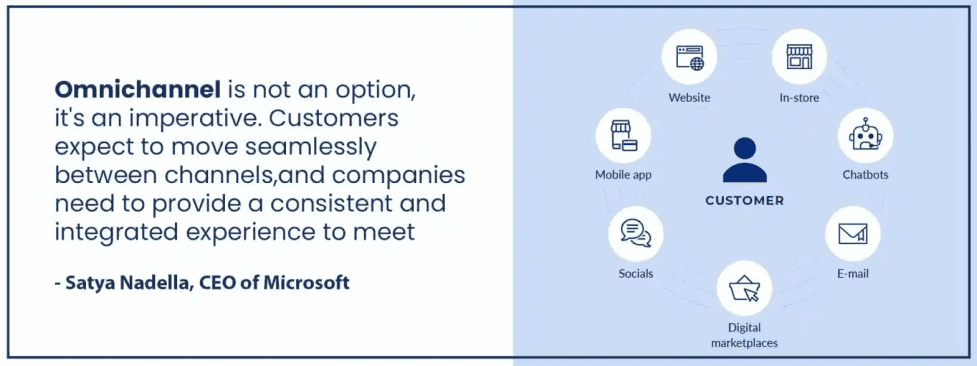
Prior to her research, Ava thought omnichannel was just another term to describe a multichannel approach. But that’s not quite right. Let’s learn the difference between the two.
Difference between a multichannel and omnichannel approach
Here's the breakdown:
- In multichannel, various communication channels work independently. This can lead to a fragmented experience where customers have to repeat themselves, which was the case with Craftopia as they provided inconsistent experience between the website and retail stores.
- In omnichannel, channels are linked. Thanks to different tools, such as integrated CRMs (like Zendesk alternatives), customer data and history move smoothly across all channels.

With channel mixes becoming more complex, many businesses beyond arts and crafts chains like Craftopia are considering omnichannel. And rightfully so, as the benefits are plentiful.
Case studies and stats that show the benefits of omnichannel
Besides the clear advantage of a quicker response time from synced communication channels, omnichannel offers several other benefits for businesses. To name just a few:
- Unified customer profile. A CRM system consolidating data from different channels is handy here. T-Mobile, for instance, uses Salesforce CRM across stores, call centers, and apps, giving agents a 360-degree customer view and reducing order processing time by 70%.
- Increased sales opportunities. Deloitte research indicates that customers with high-quality omnichannel experiences are 3.6 times more likely to make additional purchases from the same company. This opens doors for cross-selling and upselling.
- Accurate and compliant responses. Wells Fargo uses a unified platform for social media support. This ensures a consistent brand voice to over 70 million clients and helps the bank deliver a compliant and seamless experience at scale.
- Broadening audience reach. Adidas integrates Web3 into its omnichannel strategy, creating micro-communities and NFT tokens in the virtual world to engage younger audiences, particularly Gen Z.

These benefits showcase the efficiency of an omnichannel strategy. But before diving into its implementation, let's check if this is the right strategy for your specific business.
Is an omnichannel strategy right for your business?
Use our checklist to figure out if omnichannel customer support is right for you. If you answer 'yes' to any of these questions, omnichannel might be a good fit.
- Do your customers engage with you across multiple channels (phone, email, chat, in-person, etc.)?
- Do you want to expand channel support to grow engagement?
- Are your customers complaining about inconsistent experiences between channels?
- Is important context and data getting lost when customers switch channels?
- Is there a lack of visibility into customer history and interactions across channels?
- Are your customer satisfaction scores inconsistent across service channels?
Craftopia's Ava checks off 5 out of 6 items, how about you?
If any of these questions resonate with your business, it may be time to explore implementing an omnichannel customer service strategy!
Starting your omnichannel strategy: Practical steps and tips
Here are some essential best practices and tips for anyone diving into omnichannel communications. We'll illustrate these with examples from our hypothetical Craftopia and real-life scenarios.
1. Understand your customers’ preferred channels
People use many online communication tools, so their preferences can vary. Start by collecting data about your customers and how they like to engage with your brand. For example, explore performance statistics tools to uncover insights into your customers' communication preferences. Or look at some of the following data:
- Web traffic analytics
- Sales data
- Support/contact logs
- Social media insights
- Mobile app analytics
Take Craftopia's situation, for example. Since they have a strong offline and online presence, they can start by:
- Analyzing support tickets from the past year, categorizing them by the channel through which they came in
- Reviewing website analytics data to assess traffic volumes to key pages like the store locator, class registration, and product detail pages
With this data on how customers use different channels, it's time to conduct a comprehensive analysis of all existing channels.
2. Evaluate your current channels and touchpoints
The aim here is to get a complete view of how well your existing channels perform and where you can enhance the omnichannel customer service experience. To do this, you can:
- Audit existing channels. Make a thorough list of current channels, such as the website, mobile app, email, social media, online chat, in-person stores, and more, even if some are less frequently used by customers.
- Analyze usage data. Gather relevant data for each channel, like website visits, email open rates, call volume, and foot traffic, to measure customer usage and engagement.
- Review capabilities. Document the key features, functions, and capabilities of each channel in areas like purchases, support, and engagement. For instance, if you focus on phone-based customer support, it can be a great idea to make good use of call tracking.
- Map customer journeys. Illustrate typical customer journeys across channels to identify any gaps, pain points, or inconsistencies. Create separate customer journey maps for each major touchpoint customers use to get in touch, across all of your channels. Templates can be helpful:
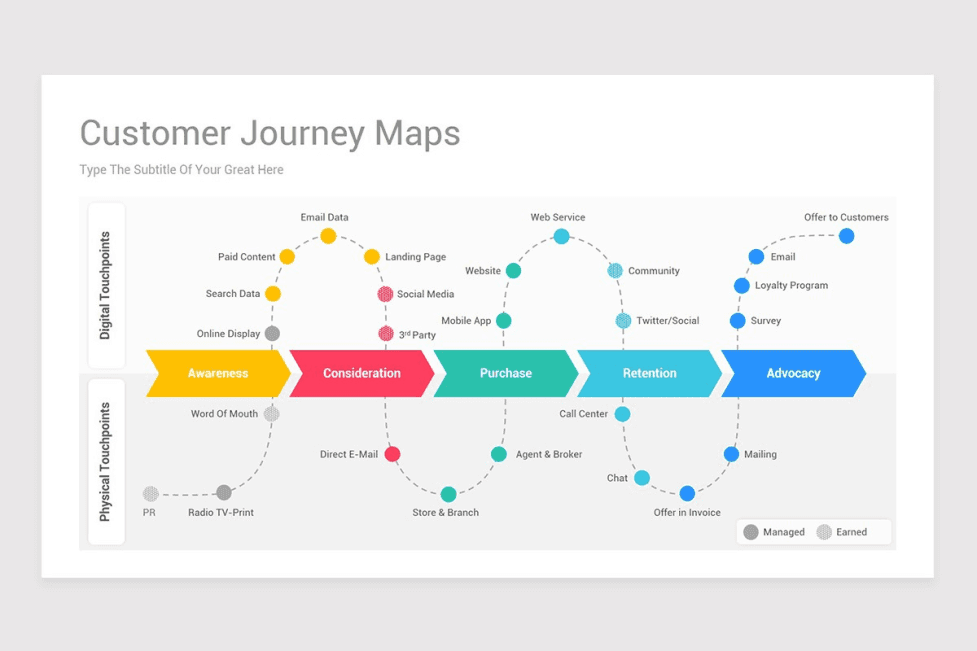
- Calculate ROI. Estimate costs versus revenue/value provided by each channel to prioritize and determine the next investments.
- Gather feedback. Collect, analyze, and take action on Voice of Customer feedback from all channels.
Now that you've reviewed all your current channels, it's time to choose the high-priority ones.
3. Choose your priority channels
Be strategic. Identify the channels that matter most for you and the ones your customers use (or complain about) the most, and focus on those. It's better to excel in a few channels than to be just okay in many.
One good way to make the right choice is to invest in a data science service to extract valuable insights from your data and implement it in choosing your priority customer support channel.
For example, Craftopia’s main problem is the disconnected experiences between two key channels — the website and retail stores. To fix this, they should integrate the website with in-store Point of Sale (POS) and inventory systems. This way, customers can easily check product availability and pricing across both channels.
4. Invest in omnichannel software
Now that you've identified your important channels, let's talk about turning your omnichannel plan into reality. The most effective way to do this is by using omnichannel software.
For Craftopia, something like Shopify's POS (Point of Sale) system could be a great choice. It helps connect online and in-store information, addressing Craftopia's main issue.
However, for online businesses, different solutions covering digital channels might work better. The key is to pick a provider based on what your business needs. Here are a few things to consider:
- Unified channels. For example, Microsoft Dynamics 365 Customer Service lets you connect channels such as messaging including chat, IVR, voice, SMS, social, and Microsoft Teams.
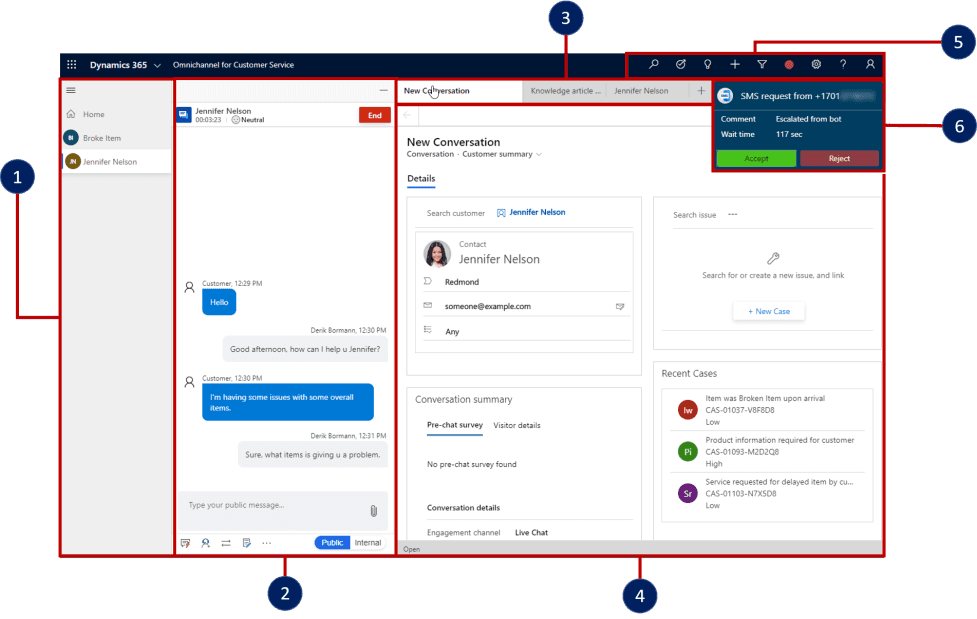
- CRM integration to keep track of all customer interactions and data in one place. Examples are Microsoft Dynamics 365 Customer Service, HubSpot CRM, and Zoho.
- Customer intelligence tools to collect detailed customer data across channels and use it to personalize engagements. Examples include:
- Customer data platforms (CDP) for a unified customer profile, like Adobe Real-Time CDP.
- Analytics and engagement hubs to understand customer behavior, like Microsoft’s Dynamics 365 Customer Insights.
- Customer journey orchestration to analyze and personalize engagements across channels, like Adobe Journey Optimizer.
- Pre-built automation for tasks like chatbots, email workflows, and customer onboarding to optimize support processes.
Many omnichannel software providers offer free trials, so you can try them out without risk.
When implementing a solution, keep an eye on key omnichannel metrics to understand your overall performance.
5. Consider setting up a knowledge base
Last but not least, a knowledge base is crucial for omnichannel support. It's like an organized library of information that helps both employees and customers with:
- Unified information. A central knowledge base is the go-to source for customer service reps across all channels like email, chat, phone, and social media.
- Self-service options. Serving as a public resource, a knowledge base lets customers find answers on their own without reaching out for support.
A solid personalized knowledge base includes self-service tutorials organized by topic or problem, chatbots, and extra resources like contact support options.
Take Hulu’s Help Center, for instance. It categorizes common knowledge base articles and lets you find relevant articles related to possible beginner questions and concerns.
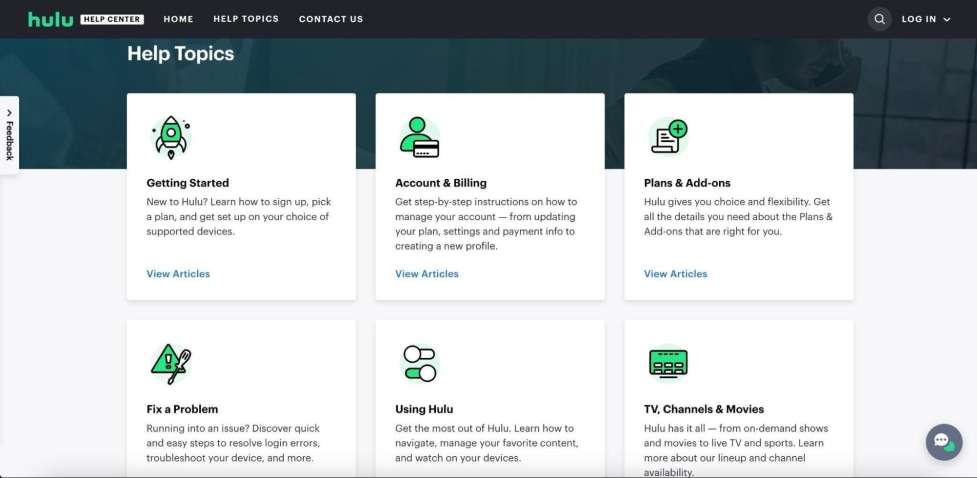
Clicking the chat icon in the bottom right corner introduces you to HuluBot, a helpful chatbot guiding you through common troubleshooting.
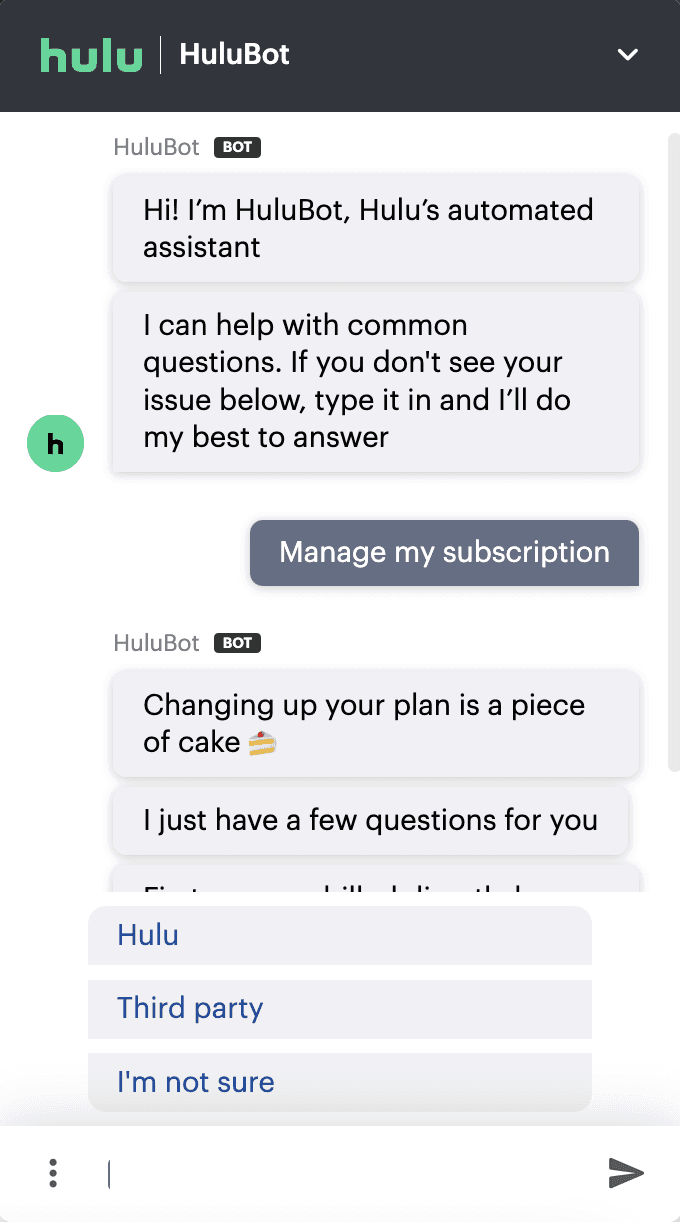
If your issue persists, you can use additional resources like reaching out to the Hulu Community or contacting support.
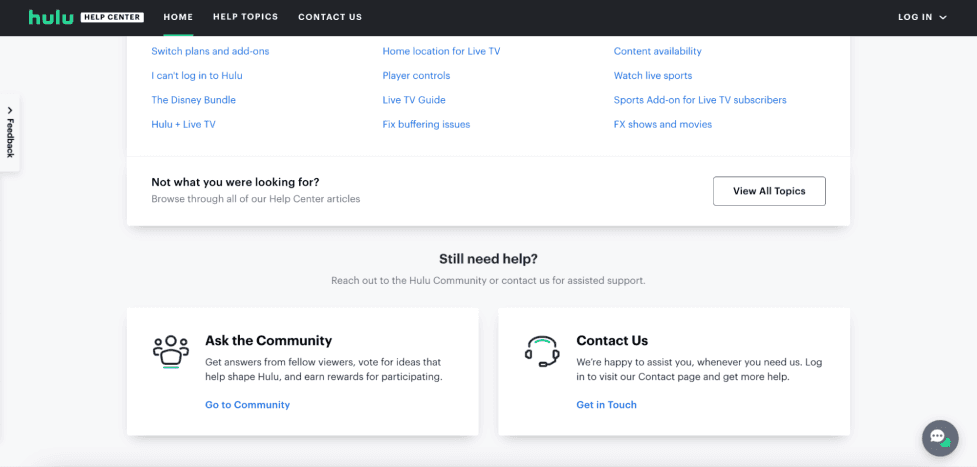
You can implement an effective knowledge base with software from companies like Helpcrunch, Salesforce Knowledge, Freshdesk, and more.
Bottom line
Modern customers have many ways to contact companies, but more channels don't have to mean more problems. For online, offline, or both businesses, syncing communication among channels can be the perfect solution to stay visible and nurture customer relationships.
That's where omnichannel customer support comes in — a strategy that integrates various channels to maintain a brand's presence. By evaluating your communication channels and choosing fitting software, you'll be on the road to unified customer data, more sales, and other benefits provided by omnichannel.
Ava seems confident about this road, how about you?

About the author
Juliia Serdiuk
Juliia Serdiuk is an Outreach Specialist at HelpCrunch, all-in-one customer service software. She is a bookworm and yoga enthusiast who appreciates life in its various manifestations.
Related articles
